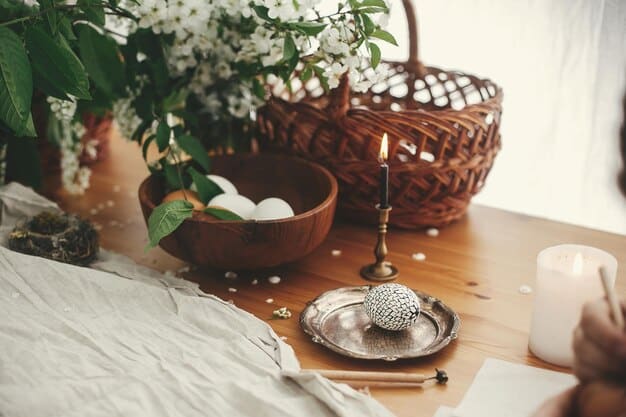Create Your Sanctuary: Sacred Space for Daily Spiritual Practice

Creating a sacred space in your home involves dedicating a specific area for spiritual practice, fostering mindfulness, peace, and connection to something greater than oneself through intentional design and personal touches.
Do you yearn for a deeper connection to your spirituality but struggle to find the time or space in your busy life? Learning how to create a sacred space in your home for daily spiritual practice can be the answer, offering a sanctuary where you can nurture your inner self and cultivate a sense of peace.
Creating a Foundation: Defining Your Sacred Space
Before diving into the specifics, it’s essential to understand what a sacred space truly means to you. It’s more than just a pretty corner of your house; it’s a dedicated area where you can connect with your inner self and foster spiritual growth.
Think of your sacred space as a refuge, a place free from distractions and the stresses of daily life. It’s where you can be present, mindful, and open to receiving guidance and inspiration.
Intention is Key
The first step in creating your sacred space is setting your intention. What do you hope to achieve in this space? Are you seeking relaxation, contemplation, meditation, creative inspiration, or something else entirely?
Clearly defining your intention will help you guide your design choices and create a space that truly supports your spiritual practice.
Choosing the Right Location
Selecting the right location is crucial. Consider factors like natural light, noise levels, and privacy. Ideally, your sacred space should be in a quiet area of your home where you won’t be easily disturbed.
- Minimize distractions: Choose a location away from high-traffic areas like the TV or kitchen.
- Consider natural light: Natural light can enhance the feeling of peace and serenity.
- Ensure privacy: The space should feel private and personal, allowing you to fully relax and connect with yourself.
Remember, your sacred space doesn’t need to be large. Even a small corner can be transformed into a powerful sanctuary.
Declutter and Cleanse: Preparing Your Physical Space
Before you begin decorating, it’s essential to declutter and cleanse the physical space. A clean and organized environment promotes clarity and focus, making it easier to connect with your inner self.
Think of this as a spiritual cleansing, removing any stagnant energy and creating a fresh start for your sacred practice.
The Power of Decluttering
Start by removing any items that are not essential to your spiritual practice. Donate or discard anything that no longer serves you or brings you joy.
Organize the remaining items in a way that feels pleasing and harmonious. Clutter can create mental and emotional clutter, hindering your ability to focus and relax.
Cleansing Rituals
The physical space also needs some spiritual cleansing rituals.
- Smudging: Use sage, palo santo, or other sacred herbs to clear the energy of the space.
- Sound cleansing: Use singing bowls, chimes, or other instruments to create resonant tones that dispel negative energy.
- Salt: Place bowls of sea salt in the corners of the room to absorb negative energy.
These rituals can enhance any room allowing you to have a spiritual practice that brings you harmony.
Once the space is decluttered and cleansed, you’ll have a clean slate to create your sacred sanctuary.

Adding Meaning: Personalizing Your Altar
The heart of your sacred space is often an altar, a dedicated area where you can place items that hold special meaning for you. This is where you can express your spirituality and honor the things that are important to you.
Your altar should be a reflection of your personal beliefs and values. There are no right or wrong ways to create an altar, so let your intuition guide you.
Choosing meaningful items
When setting up your altar, what are some items you consider putting on the surface?
Here are some ideas to get you started:
- Crystals: Use crystals to amplify your intentions and promote healing.
- Candles: Candles provide a warm and inviting atmosphere, symbolizing light and hope.
- Statues or figurines: Include representations of deities, angels, or other spiritual figures that resonate with you.
- Natural elements: Add elements like stones, shells, feathers, or flowers to connect with nature.
Arranging Your Altar
Arrange the items on your altar in a way that feels balanced and harmonious. Consider the placement of each item and how it contributes to the overall energy of the space.
Experiment with different arrangements until you find one that feels right to you. Trust your intuition and let your personal style shine through.
By personalizing your altar, you create a focal point that anchors your spiritual practice and reminds you of your intentions.
Engaging the Senses: Creating an Immersive Experience
Engaging your senses is a powerful way to deepen your spiritual practice and create a more immersive experience. By incorporating elements that appeal to sight, sound, smell, touch, and taste, you can enhance the feeling of peace and connection in your sacred space.
Consider how you can stimulate each of your senses in a way that supports your spiritual goals.
Sight: Color and Light
Use colors that evoke feelings of peace and serenity. Soft blues, greens, and purples are often associated with calmness and spirituality. Incorporate natural light whenever possible to create a warm and inviting atmosphere.
Sound: Music and Silence
Play calming music or nature sounds to create a peaceful ambiance. Alternatively, embrace silence to cultivate inner stillness and awareness.
Smell: Aromatherapy
Use essential oils, incense, or scented candles to create a pleasant and uplifting aroma. Lavender, sandalwood, and frankincense are popular choices for spiritual practice.
Touch: Textures and Materials
Incorporate soft textures and natural materials to create a comfortable and inviting space. Use cushions, blankets, or rugs to add warmth and coziness.
Taste: Herbal Teas
Enjoy a cup of herbal tea before or after your spiritual practice. Choose teas with calming and grounding properties, such as chamomile or ginger.
By engaging your senses, you create a holistic experience that deepens your connection to your spirituality.

Cultivating Mindfulness: Practices for Your Sacred Space
Your sacred space is not just a beautiful environment; it’s also a place for spiritual practice. Cultivating mindfulness is essential for connecting with your inner self and experiencing the full benefits of your sanctuary.
Explore different practices that resonate with you and incorporate them into your daily routine.
Meditation
Meditation is a powerful tool for cultivating inner peace and awareness. Sit comfortably in your sacred space and focus on your breath, a mantra, or a guided meditation. Even a few minutes of daily meditation can make a significant difference.
Journaling
Journaling is a great way to explore your thoughts and feelings. Write about your experiences, insights, and intentions in a journal dedicated to your spiritual practice.
Yoga and Movement
Here are some examples of Yoga and Movement- practices you may enjoy.
- Gentle yoga: Practice gentle yoga poses to release tension and promote relaxation.
- Tai chi or qigong: Engage in slow, flowing movements to cultivate energy and balance.
- Walking meditation: Walk mindfully in your sacred space, paying attention to each step and the sensations in your body.
Creative Expression
Engage in creative activities like painting, drawing, writing, or playing music to express your inner self and connect with your creativity.
Regular practice in your sacred space will help you cultivate mindfulness and deepen your connection to your spirituality.
Maintaining Your Sanctuary: Nurturing Your Sacred Space
Creating a sacred space is an ongoing process. To maintain its positive and transformative energy, you need to nurture it regularly.
Here are a few tips for keeping your sanctuary vibrant and welcoming:
Daily Maintenance
Take a few minutes each day to tidy up your sacred space. Dust, sweep, or wipe down surfaces to keep it clean and inviting.
Regular Cleansing
Continue to cleanse the energy of your space regularly using smudging, sound cleansing, or other rituals. This will help remove any stagnant energy and keep the space feeling fresh.
Re-Evaluate and Adjust
Periodically re-evaluate your sacred space and make adjustments as needed. As your spiritual practice evolves, your sanctuary may need to evolve with it.
Express Gratitude
Take time to express gratitude for your sacred space and the benefits it brings to your life. This will help you cultivate a deeper appreciation for your sanctuary and its role in your spiritual journey.
By nurturing your sacred space, you create a lasting sanctuary that supports your spiritual growth for years to come.
| Key Point | Brief Description |
|---|---|
| 🧘 Intention Setting | Define your spiritual goals for the space to guide design choices. |
| ✨ Altar Personalization | Fill your altar with meaningful items like crystals and candles. |
| 🌿 Sensory Immersion | Engage the senses with calming colors, sounds, and aromatherapy. |
| 🧹 Regular Maintenance | Keep the space clean and cleanse regularly to maintain positive energy. |
FAQ
▼
A space becomes sacred when it’s intentionally dedicated for spiritual practice, imbued with personal meaning, and regularly nurtured for positive energy. This intentionality is the most important thing.
▼
No, a sacred space can be any size, even a small corner of a room. What matters most is the intention and energy you bring to the space.
▼
Yes, absolutely! A garden, a balcony, or even a favorite spot in nature can serve as a beautiful and powerful sacred space. What matters is you make a connection to spiritual feelings that resonate with you in that location.
▼
Ideally, cleanse your space at least once a week, or whenever you feel the energy is stagnant. Trust your intuition and adjust as needed for your own practice.
▼
An altar isn’t essential, but it can be a helpful focal point. If you don’t want an altar, focus on creating a comfortable and inviting space for your practices.
Conclusion
Creating a sacred space in your home is a deeply personal journey that can bring profound benefits to your spiritual practice. By setting your intention, decluttering and cleansing, personalizing your altar, engaging your senses, cultivating mindfulness, and maintaining your sanctuary, you can create a haven that supports your inner journey and enhances your connection to something greater than yourself.





